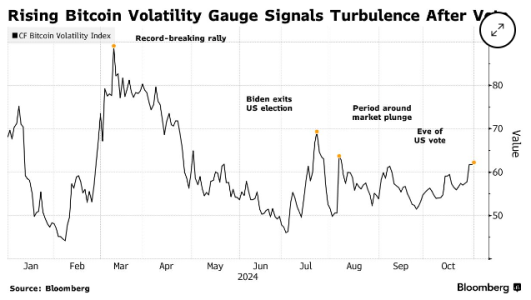Crptocurrency
Bitcoin Traders Brace for Volatile Price Swings Ahead of U.S. Election

Bitcoin Traders Brace for Volatile Price Swings Ahead of U.S. Election
As the U.S. presidential election approaches, Bitcoin traders are preparing for heightened volatility in the cryptocurrency market. A recent report from Derive.xyz, as cited by Bloomberg, reveals that Bitcoin options for October are evenly split between bearish and bullish positions. This balanced positioning indicates that traders are anticipating significant price movements in either direction. The 30-day gauge of implied volatility in Bitcoin, derived from CME Group options pricing and compiled by CF Benchmarks Ltd., has surged to its highest level since the global market upheaval in August. Data from the Deribit exchange suggests that Bitcoin’s price could fluctuate between $60,000 and $80,000 in the weeks following the U.S. election, reflecting peak open interest in both bearish and bullish options.


Introduction to the Anticipated Volatility
Overview of Current Market Sentiment
The cryptocurrency market is no stranger to volatility, but the impending U.S. election adds an additional layer of uncertainty. The evenly split options positions for Bitcoin indicate a market divided on its future direction, with traders hedging against both upward and downward movements. This cautious stance is reflective of the broader economic and political factors at play, which could significantly influence investor behavior and market dynamics.
Significance of the U.S. Election on Cryptocurrency Markets
Elections often bring about significant market shifts due to changes in fiscal and monetary policies, regulatory frameworks, and investor sentiment. The outcomes of these elections can lead to increased uncertainty or renewed confidence in financial markets, including cryptocurrencies like Bitcoin. As such, traders are keenly watching how the election results will impact Bitcoin’s price trajectory.
Detailed Analysis of Market Positions
Bearish vs. Bullish Positions
The report from Derive.xyz highlights that Bitcoin options for October are equally divided between bearish and bullish positions. This balance suggests that traders are prepared for potential downturns just as much as they are for rallies. The split indicates a lack of consensus on Bitcoin’s immediate future, making the market particularly sensitive to any new information or events that could sway investor sentiment.
Implied Volatility Index
The 30-day gauge of implied volatility for Bitcoin has reached its highest level since August’s global market upheaval. Implied volatility measures the market’s forecast of a likely movement in an asset’s price and is often used by traders to gauge market sentiment. A higher implied volatility suggests that traders expect larger price swings, which could be triggered by significant events such as the U.S. election.
Potential Price Range Post-Election
Data from the Deribit exchange indicates that Bitcoin’s price could range between $60,000 and $80,000 in the weeks following the election. This wide range reflects the high level of uncertainty and the potential for either strong bullish momentum or a significant bearish correction, depending on the election’s outcome and subsequent market reactions.
Implications for Bitcoin Traders
Short-Term Trading Strategies
Given the expected volatility, Bitcoin traders may consider adopting the following strategies:
- Hedging: Utilizing options and futures contracts to protect against potential price declines or to capitalize on anticipated rallies.
- Scalping: Engaging in short-term trades to profit from small price movements, taking advantage of the increased volatility.
- Diversification: Spreading investments across different cryptocurrencies and assets to mitigate risks associated with Bitcoin’s price swings.
Long-Term Investment Considerations
For long-term investors, the anticipated volatility presents both challenges and opportunities:
- Dollar-Cost Averaging: Consistently investing a fixed amount in Bitcoin regardless of its price, thereby reducing the impact of volatility over time.
- Holding: Maintaining a long-term position in Bitcoin, leveraging its historical performance and potential for future growth despite short-term fluctuations.
- Staking and Yield Farming: Participating in decentralized finance (DeFi) activities to earn returns on Bitcoin holdings, providing an additional income stream during volatile periods.
Expert Insights on Market Dynamics
Dr. Emily Carter, Blockchain Analyst
“The current split in Bitcoin options positions reflects a market grappling with uncertainty as the election approaches. Traders are rightly cautious, given the potential for significant policy changes that could impact Bitcoin’s adoption and regulation. It’s crucial to monitor both political developments and broader economic indicators to navigate this volatility effectively.”
Mark Thompson, Financial Strategist
“Implied volatility reaching its highest point since August signals that the market is bracing for major price movements. Traders should be prepared for rapid shifts in sentiment and consider strategies that can adapt to both bullish and bearish scenarios. Diversification and risk management will be key in these turbulent times.”
Sarah Lee, Cryptocurrency Researcher
“The anticipation surrounding the U.S. election is driving traders to adopt more sophisticated strategies to hedge against potential losses or to maximize gains. The ability to remain agile and informed will be essential for navigating the heightened volatility in the Bitcoin market.”
Future Outlook for Bitcoin Post-Election
Potential Scenarios Based on Election Outcomes
- Bullish Scenario: If the election results lead to favorable policies for cryptocurrency adoption and a robust economic outlook, Bitcoin could experience a significant price rally, potentially reaching or surpassing the upper end of the projected range.
- Bearish Scenario: Conversely, if the election results result in stringent regulations or economic downturns, Bitcoin could face downward pressure, testing the lower support levels and potentially leading to a market correction.
- Neutral Scenario: A closely contested election with mixed policy outcomes could result in a period of consolidation, with Bitcoin fluctuating within a narrower range as the market digests the implications of the results.
Long-Term Market Trends
Regardless of the immediate post-election volatility, Bitcoin’s long-term prospects remain influenced by factors such as institutional adoption, technological advancements, and its role as a hedge against inflation. Continued integration into financial portfolios and increasing acceptance among mainstream investors are likely to support its upward trajectory over time.
Monitoring Key Indicators
Traders and investors should keep an eye on the following indicators to make informed decisions:
- Election Results: The official announcement of the election winner and any accompanying policy changes.
- Regulatory Developments: New regulations or guidelines affecting cryptocurrency markets.
- Macroeconomic Data: Indicators such as GDP growth, employment rates, and inflation, which can influence investor sentiment.
- Technological Upgrades: Updates and improvements to Bitcoin’s network that could enhance its functionality and adoption.
Conclusion
As the U.S. presidential election looms, Bitcoin traders are bracing for significant price volatility driven by an evenly split options market and heightened implied volatility. The anticipated fluctuations between $60,000 and $80,000 reflect the market’s uncertainty and the profound impact that election outcomes can have on cryptocurrency dynamics. By adopting strategic trading and investment approaches, traders can navigate the upcoming volatility while positioning themselves for potential opportunities.
Benjamin Cowen’s recent prediction of a “grand finale” in altcoin price corrections and the contrasting bullish outlook from @SenseiBR_btc further emphasize the complexity and unpredictability of the current crypto market landscape. As Bitcoin continues to mature and integrate into mainstream finance, its response to political and economic events will remain a critical factor in shaping its future trajectory.
To stay updated on the latest developments in cryptocurrency markets and strategic investment insights, explore our article on latest news, where we cover significant events and their impact on the digital asset ecosystem.
Disclaimer: The information provided is not trading advice, Bitcoinworld.co.in holds no liability for any investments made based on the information provided on this page. We strongly recommend independent research and/or consultation with a qualified professional before making any investment decisions.
Crptocurrency
BTC/Gold Index Sees Biggest Single-Day Surge Since 2022 Following Trump’s Election Win

Crptocurrency
Rekt Raises $1.5M Seed Round Backed by Angels and Community, Following Sell-Out Success of Rekt Drinks

Crptocurrency
JP Morgan Analysts Expect Bitcoin and Gold Gains Under Trump Presidency

JP Morgan Analysts Expect Bitcoin and Gold Gains Under Trump Presidency
JP Morgan analysts, led by Nikolaos Panigirtzoglou, foresee a strong bullish outlook for gold and Bitcoin under President-elect Donald Trump’s administration, driven by what they term a “debasement trade” strategy. This approach aims to profit from anticipated currency devaluation and inflationary pressures, which typically benefit assets viewed as stable stores of value, including gold and Bitcoin. JP Morgan’s analysis suggests that continued demand for exchange-traded funds (ETFs), geopolitical uncertainties, and major Bitcoin acquisitions by companies like MicroStrategy will support this trend through 2025.
Key Drivers Behind JP Morgan’s Bullish Prediction
Several factors underpin JP Morgan’s expectation of gains for Bitcoin and gold in the upcoming years:
- Debasement Trade Strategy: The “debasement trade” benefits from policies that lead to currency devaluation, particularly during periods of expansionary fiscal policies. As the U.S. dollar loses value, investors often turn to hard assets like gold and Bitcoin to preserve purchasing power, positioning them as attractive hedges.
- Geopolitical Tensions and Trade Policies: Trump’s stance on trade tariffs and the possibility of increased geopolitical tensions could lead to further dollar devaluation, adding to the appeal of Bitcoin and gold as alternative assets.
- Rising Demand for Gold and Bitcoin ETFs: The analysts note significant demand for Bitcoin and gold ETFs since mid-2023, driven largely by retail investors. As institutional interest grows, these ETFs provide an accessible means of exposure, bringing fresh capital to both assets.
- MicroStrategy’s Bitcoin Acquisition Plans: MicroStrategy, a major corporate holder of Bitcoin, has announced plans to increase its holdings. This institutional investment, combined with favorable economic conditions, is expected to create upward pressure on Bitcoin’s price, signaling confidence among large-scale investors.
The Role of Gold and Bitcoin as Inflation Hedges
Both gold and Bitcoin are widely recognized as stores of value that can serve as inflation hedges. In periods of high inflation or economic uncertainty, investors tend to favor assets that are not directly tied to fiat currencies, making gold and Bitcoin particularly attractive. Here’s how each asset fulfills this role:
- Gold: Historically, gold has been a go-to asset during periods of inflation and currency devaluation. Its tangible, finite supply makes it a safe haven in times of economic instability, offering stability when other assets might be declining in value.
- Bitcoin: While relatively new, Bitcoin’s limited supply of 21 million coins positions it as a “digital gold” with deflationary characteristics. Investors increasingly view Bitcoin as an inflation hedge, especially as regulatory clarity and institutional interest grow.
How Trump’s Economic Policies Could Boost Gold and Bitcoin
Under Trump’s administration, certain economic policies could amplify demand for Bitcoin and gold. Here’s what JP Morgan analysts highlight as key areas of influence:
- Expansionary Fiscal Policies: Trump’s prior administration implemented tax cuts and expansionary measures that drove economic growth but also increased federal debt. If similar policies are enacted, they could result in inflationary pressures, driving up demand for assets like gold and Bitcoin as stores of value.
- Increased Tariffs and Geopolitical Uncertainty: Trade policies, particularly tariffs, can lead to currency instability. Bitcoin and gold could benefit as investors seek out assets with less exposure to fiat currency fluctuations and trade uncertainties.
- Support for Financial Innovation: Trump has previously expressed interest in fostering innovation within the financial sector, which may include support for cryptocurrency regulation. A regulatory environment that favors digital assets could encourage institutional investment, further supporting Bitcoin’s price growth.
Growing ETF Demand Signals Institutional Interest
The report also highlights the impact of ETF demand on Bitcoin and gold prices. The introduction of ETFs for both assets has allowed a broader range of investors to participate in these markets, bringing liquidity and stability. Key points include:
- Retail Investor Demand: Since mid-2023, retail interest in ETFs has surged, particularly for Bitcoin ETFs. These products provide convenient and regulated access to Bitcoin, fueling demand and adding stability to its market.
- Institutional Adoption of Bitcoin ETFs: With major players like BlackRock and Fidelity entering the Bitcoin ETF market, institutional adoption is likely to increase, encouraging further investments. ETFs lower the entry barrier for large investors and hedge funds, contributing to Bitcoin’s mainstream acceptance.
MicroStrategy’s Bitcoin Strategy and Institutional Confidence
MicroStrategy has been one of the most vocal institutional supporters of Bitcoin, holding significant amounts of BTC on its balance sheet. The company’s plans for continued Bitcoin acquisitions reflect a broader trend of institutional confidence in Bitcoin as an asset class:
- Corporate Bitcoin Holdings: By increasing its Bitcoin reserves, MicroStrategy is signaling confidence in Bitcoin’s long-term value, potentially inspiring other companies to follow suit. This institutional buy-in could stabilize Bitcoin’s price and encourage broader adoption.
- Market Influence: MicroStrategy’s Bitcoin holdings influence market sentiment, as its public commitment to Bitcoin boosts investor confidence and supports a long-term bullish outlook.
Risks to JP Morgan’s Prediction
While JP Morgan’s outlook is optimistic, analysts have identified potential risks that could impact Bitcoin and gold’s performance:
- Regulatory Changes: Shifts in U.S. regulatory policy, particularly around digital assets, could introduce volatility to Bitcoin’s price. Strict regulations could dampen institutional participation and ETF demand, slowing Bitcoin’s growth.
- Economic Policy Reversals: If Trump’s administration implements policies that strengthen the dollar, such as reducing tariffs or prioritizing economic stability, the demand for Bitcoin and gold as inflation hedges may decrease.
- Market Volatility: Bitcoin’s inherent volatility remains a consideration for investors. Market corrections could impact short-term performance, even with strong long-term fundamentals.
Conclusion
JP Morgan’s analysis underscores a favorable outlook for Bitcoin and gold under Trump’s presidency, with expectations that inflationary policies, rising ETF demand, and strategic acquisitions by firms like MicroStrategy will drive these assets’ growth. The “debasement trade” strategy, geared toward profiting from currency devaluation, supports this trend by encouraging investment in assets seen as stores of value during economic uncertainty.
If these factors align, Bitcoin and gold could experience significant gains in the coming years, with Bitcoin’s expanding role as a digital store of value potentially setting new price benchmarks. For investors, this forecast highlights the strategic value of these assets within a diversified portfolio, particularly as the economy navigates potential inflation and currency pressures.
For further insights on Bitcoin, gold, and inflationary trends, explore our latest market analysis on investment strategies and asset performance under shifting economic policies.
Disclaimer: The information provided is not trading advice, Bitcoinworld.co.in holds no liability for any investments made based on the information provided on this page. We strongly recommend independent research and/or consultation with a qualified professional before making any investment decisions.
-

 Startup Stories1 year ago
Startup Stories1 year agoWhy Millennials, GenZs Are Riding The Investment Tech Wave In India
-

 Startup Stories1 year ago
Startup Stories1 year agoStartups That Caught Our Eyes In September 2023
-

 Startup Stories1 year ago
Startup Stories1 year agoHow Raaho Is Using Tech To Transform India’s Fragmented Commercial Trucking
-

 Startup Stories12 months ago
Startup Stories12 months agoMeet The 10 Indian Startup Gems In The Indian Jewellery Industry’s Crown
-

 Crptocurrency8 months ago
Crptocurrency8 months agoLither is Making Crypto Safe, Fun, and Profitable for Everyone!
-

 Startup Stories1 year ago
Startup Stories1 year agoHow Volt Money Is Unlocking The Value Of Mutual Funds With Secured Lending
-

 Startup Stories1 year ago
Startup Stories1 year agoWhy Moscow-Based Kladana Considers Indian SME Sector As The Next Big Market For Cloud Computing
-

 E-commerce1 year ago
E-commerce1 year agoTop Online Couponing Trends To Watch Out For In 2016




